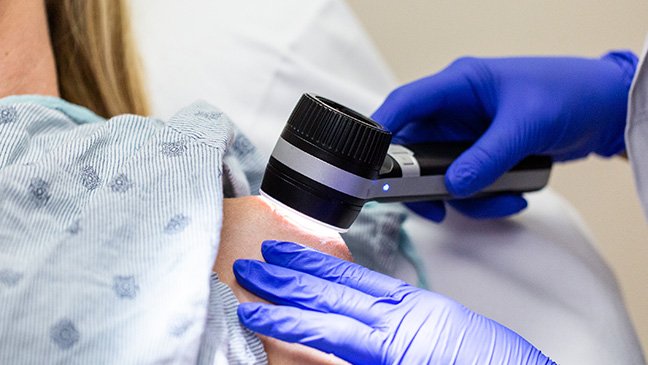A dermatologist's skin care routine
- Diseases
- Acoustic Neuroma (16)
- Adrenal Gland Tumor (24)
- Anal Cancer (70)
- Anemia (2)
- Appendix Cancer (18)
- Bile Duct Cancer (26)
- Bladder Cancer (74)
- Brain Metastases (28)
- Brain Tumor (234)
- Breast Cancer (726)
- Breast Implant-Associated Anaplastic Large Cell Lymphoma (2)
- Cancer of Unknown Primary (4)
- Carcinoid Tumor (8)
- Cervical Cancer (164)
- Colon Cancer (168)
- Colorectal Cancer (118)
- Endocrine Tumor (4)
- Esophageal Cancer (44)
- Eye Cancer (36)
- Fallopian Tube Cancer (8)
- Germ Cell Tumor (4)
- Gestational Trophoblastic Disease (2)
- Head and Neck Cancer (14)
- Kidney Cancer (130)
- Leukemia (342)
- Liver Cancer (50)
- Lung Cancer (286)
- Lymphoma (278)
- Mesothelioma (14)
- Metastasis (30)
- Multiple Myeloma (100)
- Myelodysplastic Syndrome (60)
- Myeloproliferative Neoplasm (6)
- Neuroendocrine Tumors (16)
- Oral Cancer (102)
- Ovarian Cancer (178)
- Pancreatic Cancer (160)
- Parathyroid Disease (2)
- Penile Cancer (14)
- Pituitary Tumor (6)
- Prostate Cancer (150)
- Rectal Cancer (58)
- Renal Medullary Carcinoma (6)
- Salivary Gland Cancer (14)
- Sarcoma (238)
- Skin Cancer (300)
- Skull Base Tumors (56)
- Spinal Tumor (12)
- Stomach Cancer (66)
- Testicular Cancer (28)
- Throat Cancer (92)
- Thymoma (6)
- Thyroid Cancer (100)
- Tonsil Cancer (30)
- Uterine Cancer (86)
- Vaginal Cancer (18)
- Vulvar Cancer (22)
- Cancer Topic
- Adolescent and Young Adult Cancer Issues (22)
- Advance Care Planning (12)
- Biostatistics (2)
- Blood Donation (18)
- Bone Health (8)
- COVID-19 (360)
- Cancer Recurrence (120)
- Childhood Cancer Issues (120)
- Clinical Trials (628)
- Complementary Integrative Medicine (22)
- Cytogenetics (2)
- DNA Methylation (4)
- Diagnosis (238)
- Epigenetics (6)
- Fertility (62)
- Follow-up Guidelines (2)
- Health Disparities (14)
- Hereditary Cancer Syndromes (128)
- Immunology (18)
- Li-Fraumeni Syndrome (8)
- Mental Health (122)
- Molecular Diagnostics (8)
- Pain Management (62)
- Palliative Care (8)
- Pathology (10)
- Physical Therapy (18)
- Pregnancy (18)
- Prevention (936)
- Research (390)
- Second Opinion (78)
- Sexuality (16)
- Side Effects (616)
- Sleep Disorders (10)
- Stem Cell Transplantation Cellular Therapy (216)
- Support (408)
- Survivorship (328)
- Symptoms (182)
- Treatment (1788)
6 things to know about Retin-A
3 minute read | Published September 28, 2022
Medically Reviewed | Last reviewed by an MD Anderson Cancer Center medical professional on September 28, 2022
Choosing skin care products can be overwhelming. There are so many ingredients and so many claims of benefits.
But there is one ingredient that has stayed the course since its introduction in the 1960s. Retin-A is a form of vitamin A used to rejuvenate skin and, in some cases, treat skin spots that may be precancerous.
“Retin-A is a great product,” says dermatologist Anisha Patel, M.D. “The active ingredient is tretinoin and the main thing it does is regulate your skin cycle, so it makes your skin look brighter.”
Here are six things she wants you to know about Retin-A.
1. Retin-A works by refreshing skin cells.
Retin-A’s active ingredient, tretinoin, was created as a treatment for acne. It works by normalizing skin cell turnover. It also stimulates collagen and helps reduce dark spots and wrinkles.
“Because it regulates the skin cycle, you don’t have a layer of dead skin and that gives you a more even texture to your skin,” says Patel. “It also decreases the size of your oil glands so you’re less likely to get clogged pores or clogged hair follicles.”
2. There are over-the-counter options.
Retin-A typically requires a prescription, but you may find it is not covered by insurance for cosmetic use. There is an over-the-counter option you can consider.
“Look for brands that contain adapalene,” says Patel. “That ingredient was previously only available with a prescription, and now it’s available over-the-counter.”
You could also look for retinol, which is a milder form of Retin-A that can be found in many over-the-counter skin care products. But the effectiveness of retinol products is not as well-proven.
3. Sun protection is especially important when using Retin-A or retinol.
Sunscreen with at least SPF 30 should be used every day to protect your skin from the sun’s UV rays. This is especially important when you’re using Retin-A or retinol products because these make your skin more sensitive to the sun.
4. Retin-A isn’t right for everyone.
Some people should not use Retin-A. “People who are on photosensitizing medications should avoid it because it does have that sun sensitivity side effect,” says Patel. “I would also not recommend it for people with inflammatory skin conditions like rosacea or for cancer patients on active chemotherapy.”
Photosensitizing medications include some antibiotics, blood pressure medicines as well as other medicines. Let your doctor know if you are using Retin-A. If you are pregnant, avoid Retin-A, as it can cause fetal defects.
5. Irritation is normal when you start using Retin-A.
Retin-A can cause redness and irritation as your skin gets used to it, so it’s important to start slowly.
Start by using a small amount every third night for a week, and then start using a small amount every other night. Once your skin is comfortable, try every night and drop back to every other night if you notice redness or irritation on your skin. If you use Retin-A, your dermatologist can adjust the strength of your prescription cream.
6. Use Retin-A consistently to get the best results.
Retin-A does not necessarily produce instant results, so patience is required. Stick with it, and incorporate it into your routine to get the best results.
“Retin-A can be a nice medication to use as long as you are mindful of the potential side effects,” says Patel. “Pay special attention to sun safety because if you use Retin-A and keep getting damaging sunburns, it will be counterproductive.”
Request an appointment at MD Anderson online or by calling 1-877-632-6789.

It regulates your skin cycle, so it makes your skin look brighter.
Anisha Patel, M.D.
Physician






